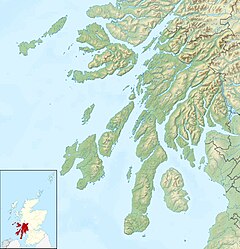
Back An t–Àrchar Welsh Arrochar (Argyll) Basque Arrochar French An t-Arar Irish An Tairbeart Iar Scots/Gaelic Arrochar Italian
This article needs additional citations for verification. (October 2011) |
Arrochar, Argyll
| |
|---|---|
 Arrochar with Ben Lomond behind, taken from the path to The Cobbler. | |
Location within Argyll and Bute | |
| OS grid reference | NN 29700 04300 |
| Council area |
|
| Lieutenancy area |
|
| Country | Scotland |
| Sovereign state | United Kingdom |
| Post town | Arrochar |
| Postcode district | G83 |
| Dialling code | 01301 |
| UK Parliament |
|
| Scottish Parliament |
|
Arrochar (/ˈærəxər/ ARR-ə-khər; Scottish Gaelic: An t-Àrchar [ən̪ˠ t̪aːɾəɾ] or An Tairbeart an Iar) is a village located near the head of Loch Long, on the Cowal Peninsula, in Argyll and Bute, Scottish Highlands. The Arrochar Alps are named after the village. The village is within the Loch Lomond and The Trossachs National Park.[1]
Historically in Dunbartonshire, it is overlooked by a group of mountains called the Arrochar Alps, and in particular by the distinctive rocky summit of the Cobbler. It enjoys good communications as it is at the junction of the A83 and A814 roads and is served by Arrochar and Tarbet railway station. In addition the A82 road runs through Tarbet two miles (three kilometres) east.
For over five centuries this area, the feudal barony of Arrochar, was held by the chiefs of Clan MacFarlane and before them by their ancestors the barons of Arrochar. The family is Celtic in the male line and native to their Highland homeland of tall peaks and deep lochs just above the waist of Scotland. The settlement was a key target for Viking raiders who took their boats two miles (three kilometres) overland to Tarbet to attack the unprotected inland settlements at Loch Lomond [2] before their defeat in 1263 at the battle of Largs.
The western end of Arrochar marks the traditional boundary of Argyllshire and Dunbartonshire, and this remained the case under local government reorganisation in 1975. However, in 1996 the boundaries of Argyll and Bute and West Dunbartonshire were substantially redrawn, bringing the whole area into Argyll and Bute.
- ^ "Archived copy" (PDF). Archived from the original (PDF) on 14 June 2019. Retrieved 17 January 2017.
{{cite web}}: CS1 maint: archived copy as title (link) - ^ "Loch Lomond Archaeology". Archived from the original on 15 August 2007.
© MMXXIII Rich X Search. We shall prevail. All rights reserved. Rich X Search
